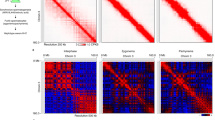Abstract.
Homologous chromosomes initially undergo weak alignments that bring homologous sequences into register during meiosis. These alignments can be facilitated by two types of mechanisms: interstitial homology searches and telomere-telomere alignments. As prophase (and chromatin compaction) proceeds, these initial pairings or alignments need to be stabilized. In at least some organisms, such as Saccharomyces cerevisiae and S. pombe, these pairings can apparently be maintained by the creation of recombination intermediates. In contrast, synapsis during zygotene may be able to facilitate and/or maintain chromosome pairing even in the absence of exchange in several higher organisms. It thus seems possible that the synaptonemal complex plays a role both in maintaining homolog adhesion during meiotic prophase and, more speculatively, in facilitating meiotic exchange.
Similar content being viewed by others
Author information
Authors and Affiliations
Additional information
Received: 15 November 1999; in revised form: 17 January 2000 / Accepted: 18 January 2000
Rights and permissions
About this article
Cite this article
Walker, M., Hawley, R. Hanging on to your homolog: the roles of pairing, synapsis and recombination in the maintenance of homolog adhesion. Chromosoma 109, 3–9 (2000). https://doi.org/10.1007/s004120050407
Issue Date:
DOI: https://doi.org/10.1007/s004120050407




